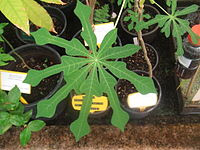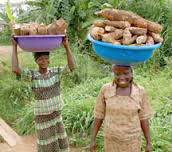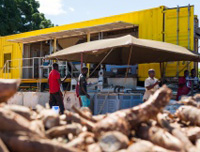Start of cassava-pro

History
Cassava, or manioc (Manihot esculenta ), is a root crop native to tropical America that is now consumed by millions of people throughout the tropics, and is used in food preparation in many industrialized processes. Although it is not well known outside the tropics, cassava now accounts for about 30 percent of the world production of roots and tubers. It is an exceptional producer of carbohydrates and a plant better able to tolerate seasonal drought than other major food crops. Plant Biology The cassava plant is a perennial woody shrub that grows from about one to three meters in height. The leaves are palmate (hand-shaped) and dark green in color. The cone-shaped roots are starch storage organs covered with a papery bark and a pink to white cortex. The flesh ranges from bright white to soft yellow. Over five thousand varieties of cassava are known, each of which has its own distinctive qualities and is adapted to different environmental conditions. The cassava plant is hardy and better able to tolerate drought and poor soil conditions than most other food plants. It can grow in extremely poor, acidic soils because it forms a symbiotic association with soil fungi (mycorrhizae). It is also one of the most productive food plants in terms of carbohydrate production per unit of land, and unequalled in its ability to recover when foliage is lost or damaged by diseases or pests.






